Stem Decays
Key Wildlife Value:
Stem decay fungi are essential to the development of wildlife habitat in dead wood. They soften wood, causing it to become an attractive and useful substrate for excavation by cavity nesters and carpenter ants. Some decay fungi also cause the formation of hollow trees. Hollows cannot form once a tree has died; they form only in living trees infected with heartwood decay fungi. A hollow tree is formed when certain heartwood decay fungi cause advanced decay that collapses, leaving a protective shell of live sapwood surrounding a hollow chamber. Decayed stems frequently become weakened and break, creating broken tops, down wood, and unique bole structures useful to wildlife for nesting, roosting, and resting. Stem breakage caused by decay fungi also contributes to canopy gap formation with associated increases in forest structural diversity and sometimes, compositional diversity. Decay-softened wood provides favorable habitat for other decomposer organisms that form the basis of the food chain in forest ecosystems. Fruiting bodies and other parts of some decay fungi are fed upon by wildlife. Decay fungi also play a significant role in recycling wood to soil.
Distribution in Oregon and Washington:
Found throughout both states.
Hosts:
All species of trees are hosts to one or more species of stem decay fungi. Table 1 provides a summary of important stem decay species found in Oregon and Washington and their respective hosts.
Table 1. Summary of important stem decays of Oregon and Washington and their hosts.
| Common Name | Scientific Name | Hosts |
|---|---|---|
| Aspen trunk rot
Close-up of external indicator (conk)

|
Phellinus tremulae | Quaking aspen |
| Brown crumbly rot (red belt fungus)
Red belt fungus conks has a distinctive red band along the perimeter when mature and fresh

|
Fomitopsis pinicola | Most western conifers |
| Brown cubical butt and pocket rot of cedar
Cedar brown pocket rot occurs in isolated large pockets of brown cubical decay. Seen in longitudinal.

|
Postia sericeomollis | Western redcedar |
| Brown cubical rot (sulfur fungus)
Fruiting bodies on dead Sitka spruce & hemlock in southeast Alaska

|
Laetiporus conifericola, L. gilbertsonii | L. conifericola - Douglas-fir, true firs, pines, hemlocks, spruces, larch, western redcedar L. gilbertsonii – oaks and eucalyptus |
| Brown stringy trunk rot of hardwoods | Spongipellis delectans | Black cottonwood, maples, alders, and oaks |
| Brown top rot (rose conk) | Fomitopsis cajanderi | Douglas-fir, grand fir, larch, lodgepole pine, ponderosa pine, white pines, hemlocks and spruces |
| Brown trunk rot (quinine fungus)
Typical quinine conk fruiting high on the stem of a tree

|
Laricifomes officinalis | Douglas-fir, pines, western larch, spruces, and hemlocks; occasionally on true firs |
| Hardwood trunk rot (false tinder conk)
Hardwood trunk rot

|
Phellinus igniarius | Maples, alders, quaking aspen, paper birch, black cottonwood, oaks, golden chinquapin, and many other hardwoods |
| Heterobasidion root disease (root and butt decay)
Fruiting Bodies

|
Heterobasidion occidentale, H. irregulare | H.occidentale – true firs, hemlocks, Douglas-fir, spruces H. irregulare – pines, junipers, incense cedar, oaks and various other hardwoods |
| Innonotus trunk rot
Fruiting Bodies

|
Inonotus dryophilus, I. dryadeus, I. andersonii | Primarily oaks, occasionally other hardwoods and conifers |
| Juniper pocket rot
Fomes juniperinus on salt cedar

|
Pyrofomes demidoffii | Western juniper |
| Mottled rot (yellow cap fungus)
Fruiting bodies

|
Pholiota adiposa, P. limonella, populnea | True firs, hemlocks, pines, spruces, yew, alders, quaking aspen, black cottonwood, maples; infrequently on willow |
| Pitted sap rot (purple conk)
Fruiting bodies

|
Trichaptum abietinum | All conifers |
| Pocket dry rot (pecky rot) | Oligoporus amarus | Incense-cedar |
| Red heart rot
Fruiting bodies

|
Stereum sanguinolentum | Spruces, Douglas-fir, hemlocks, true firs, pines, western larch, and true firs |
| Red ring rot (white speck)
Fruiting bodies on larch

|
Porodaedalea pini | Douglas-fir, western larch, pines, hemlocks, spruces, true firs, yew; infrequently on western redcedar, western juniper, oaks, maples, rarely on incense-cedar, Alaska yellow cedar, Port-Orford-cedar, and alders |
| Red ring rot canker (butterfly conk) | Porodaedalea cancriformans | Grand fir, white fir, Shasta red fir, noble fir, Pacific silver fir, and subalpine fir |
| Redcedar white ring rot
Symptoms

|
Ceriporiopsis rivulosa | Western redcedar |
| Redwood cubical rot | Oligoporus sequoiae | Coast redwood |
| Rust red stringy rot (Indian paint fungus)
Conk

|
Echinodontium tinctorium | True firs and hemlocks; infrequent on Engelmann spruce |
| Scaly cap fungus | Neolentinus lepideus | Pines, western redcedar, incense cedar, hemlocks, true firs, and Douglas-firs |
| Schweinitzii root and butt rot (velvet top fungus)
Phaeolus schweinitzii conks are yellow-green when fresh but age rapidly to a yellow-brown and finally dark brown color. They have a velvety cap, a short stem (stipe) and a pored green to brown lower surface

|
Phaeolus schweinitzii | Douglas-fir, western larch, Engelmann spruce, Sitka spruce, lodgepole pine, ponderosa pine, Jeffrey pine, western white pine, and sugar pine; occasionally true firs, hemlocks, and western redcedar |
| Sterile conk rot of birch (cinder conk)
Fungal wedge

|
Inonotus obliquus | Paper birch; rarely on black cottonwood |
| Stringy butt rot (yellow root rot)
Fruiting bodies

|
Perenniporia subacida | Hemlocks, Douglas-fir, lodgepole pine, western larch, grand fir, and western redcedar |
| White mottled rot
Fruiting bodies from Banská Štiavnica, Slovakia

|
Ganoderma applanatum | Maples, bay laurel, alders, oaks, willows, and many other hardwoods and conifers |
| White pocket rot (lion’s mane fungus)
Fruiting bodies

|
Hericium erinaceus | Oaks, maples, ash, and a wide variety of other hardwoods |
| White spongy trunk rot (tinder conk)
Fruiting bodies

|
Fomes fomentarius | Paper birch, alders, black cottonwood, willows, oaks, quaking aspen, cherries, and maple |
| White trunk rot of conifers
Fruiting bodies

|
Phellinus hartigii | Hemlocks, true firs, and yew |
| White trunk rot of hardwoods
Fruiting bodies

|
Phellinus robustus, P. everhartii, P. gilvus | Oaks |
| Yellow pitted rot (coral fungus)
Examples of the coral mushroom, Hericium abietis (Coral Hydnum)

|
Hericium abietis | True firs, hemlocks and spruces |
| Yellow ring rot in western redcedar | Coniferiporia weirii | Western redcedar |
Diagnosis:
Fungal fruiting bodies, which typically are leathery or woody conks

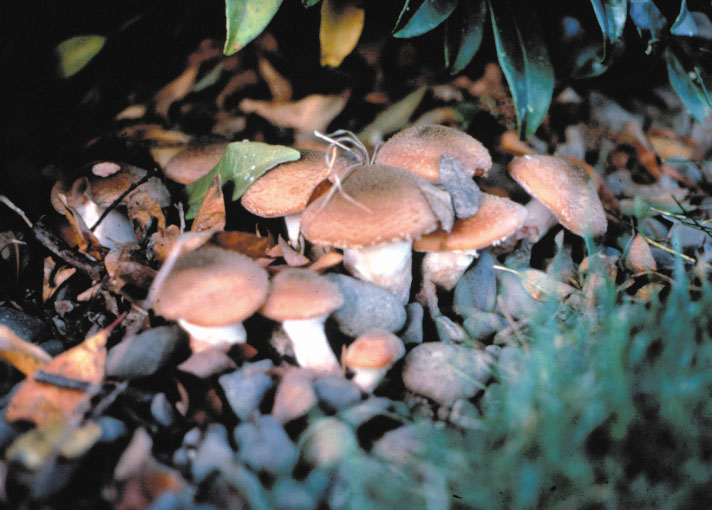
Some decay species affect one specific wood component, such as heartwood or sapwood, while others affect both heartwood and sapwood. As a general rule, heartrot fungi tend to produce conks that are few in number and associated with living and dead branch junctions, branch stubs, and knots, compared to saprots and other saprophytic fungi, which tend to produce large numbers of conks that are randomly located over the tree bole surface. Other decay indicators include punk knots, broken boles, flat faces, bole scars, bayonet tops, forked tops, openings into the stem interior, and piles of sawdust at the base of the tree caused by carpenter ant activity.
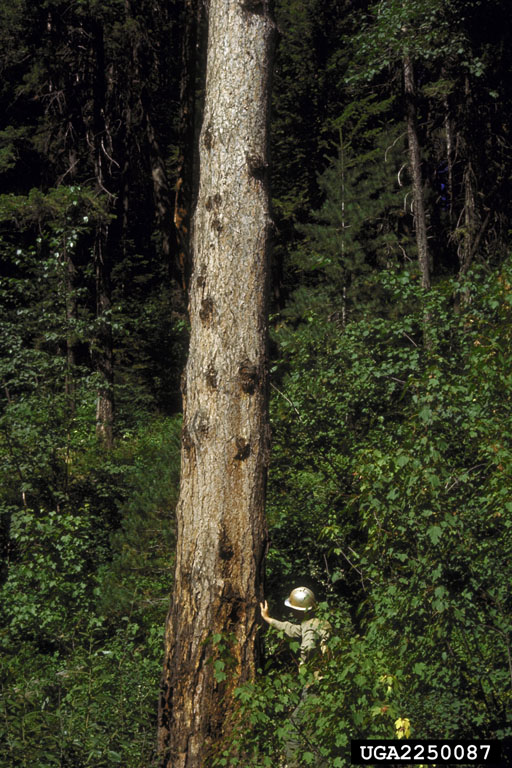
Life History:
Heart rot fungi survive primarily in the heartwood of living trees, and spread via airborne spores produced by fruiting bodies. Spores germinate and develop into vegetative structures capable of extracting nutrients from wood. The spores typically gain entry to trees by colonizing exposed wood at bole breaks, bark wounds, or branch stubs, and some enter through root stubs or damaged roots. Infections in young trees can initiate a sequence of processes that result in long-term internal decay and cavities in large, mature trees. In general, a tree resists the spread of invading fungi and bacteria through a process called compartmentalization, which can confine invaders to the wood present at the time of wounding. As the tree continues to grow each year, it forms successive outer layers of sound, healthy wood that cover the colonized wood, and over time the colonized sapwood is converted into heartwood. To various degrees, heartrot fungi are able to overcome compartmentalization barriers and their digestion of various wood components results in wood decay. Two types of decays are recognized; white rots and brown rots. White rots create decayed wood that often tends to be lighter in color, with a stringy texture or a pocketed appearance. Brown rots create columns or pockets of decayed wood that is dark brown, dry and fragile, and that tends to break up into cubes or to easily crumble. The decay process is usually slow, taking from many years to several decades for advanced decay to develop. Some heart rot fungi stop decaying after the tree dies, while others may continue developing in wood after a tree has fallen or even after the tree has been made into lumber. Fruiting bodies vary in form from fleshy mushrooms to woody brackets called conks. They often are produced only after extensive decay has developed.
Life histories of sap rot fungi are similar to those of heart rot fungi, except their activity is primarily restricted to sapwood.
Some stem decay fungi, such as Fomitopsis pinicola, cause decay in both sapwood and heartwood.
Important Habitats and Spread Dynamics:
Heartrots are generally more prevalent in unmanaged stands, old growth stands, in older trees (which often are larger trees), and in stands where trees have suffered frequent or extensive wounding, such as previously partially cut stands with multiple entries, old burned areas, or areas where frequent breakage occurs due to snow, wind, or ice. Heartwood decay spread typically is a relatively slow, gradual process that involves a cycle of wounding (enabling infection or activation), decay, and breakage. When tree boles decayed by heartrot fungi break, they often strike and wound nearby trees as they fall. Windborne decay fungus spores may then infect these wounded trees, or, as in the case of Indian paint fungus, Echinodontium tinctorium, dormant infections may be activated. The wounded trees then develop decay and eventually break, perpetuating the cycle. The effect of this small-scale disturbance in most mature forests is a series of small, shifting canopy gaps. Occasionally, when infection levels are extremely high, an unusually severe storm event will interact to cause levels of breakage resulting in canopy gaps several acres in size.
Saprots and other saprophytic wood decaying fungi are most prevalent in dead standing and down trees. They may occur on dead portions of the bole of living trees, or rarely, on severely weakened trees just before they die. They are spread by windborne spores or sometimes are carried into trees by excavating insects. Mycelial fragments of commonly occurring Cryptoporus volvatus are carried from infected into uninfected trees by many species of bark beetles and wood borers.
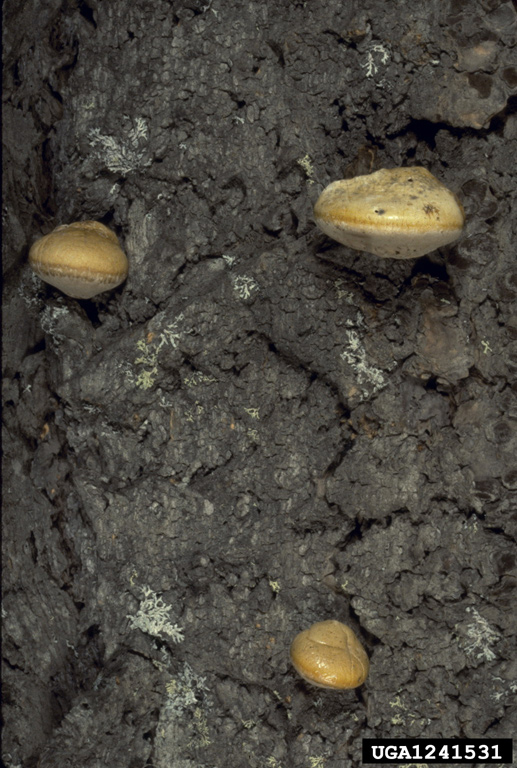
Opportunities for Manipulation to Increase Wildlife Habitat:
Intentional wounding of mature trees that mimics the placement and size of natural wounds may initiate colonization of stem decaying fungi or activate dormant infections. Mature trees in decay-deficient second-growth stands may be intentionally wounded by topping, limbing, or removing large sections of bark from the bole in hopes of initiating colonization by stem decaying fungi or activating dormant infections. Because tree injuries from commercial logging activities and prescribed burning mimic natural wounds from natural tree failure, weather, and wildfire, allowing or encouraging residual tree wounding during commercial logging activities may eventually result in decay that provides habitat for cavity-dependent wildlife and contributes over the long term to canopy gaps through tree breakage. Tree wounding may be encouraged during selective harvest activities by operating during spring when wounding is more likely to occur, and relaxing some controls over falling and yarding practices. Unintentional logging wounds occur most frequently in the lower boles and crowns, however, many cavity-dependent species prefer the habitat zone of the upper tree crown. Intentional wounding and top-breakage with logging equipment that targets the upper crowns of selected residual trees can encourage the development of upper bole stem decay columns in live trees. Underburning stands having a component of true firs or hemlock is likely to result in wounding with subsequent decay that is located in the basal portions of tree boles. It should be noted that methods of intentional wounding have inherent uncertainties regarding the colonization of the wounded area by stem decay fungi or the occurrence and location of dormant infections.
Artificial inoculation with heartwood decay fungi to create cavity-nesting habitat in sound, living conifers is a potential strategy that requires further development in Oregon and Washington before operational application can be recommended. Evaluations of trial results by Filip et al. (2004) and Filip et al. (2011) indicate that the tested artificial inoculation methodologies were slower, costlier, and less to no more effective in producing stem decay within a 5-10 year period than other lower-input methods, such as tree topping or shooting sterile dowels into trees using a shotgun or rifle. Further testing and refinement of substantially modified artificial inoculation methodology is needed before artificial inoculation can be considered a viable operational strategy in Oregon and Washington.
Potential Adverse Effects:
Decay caused by a few species, especially Echinodontium tinctorium (Indian paint fungus),

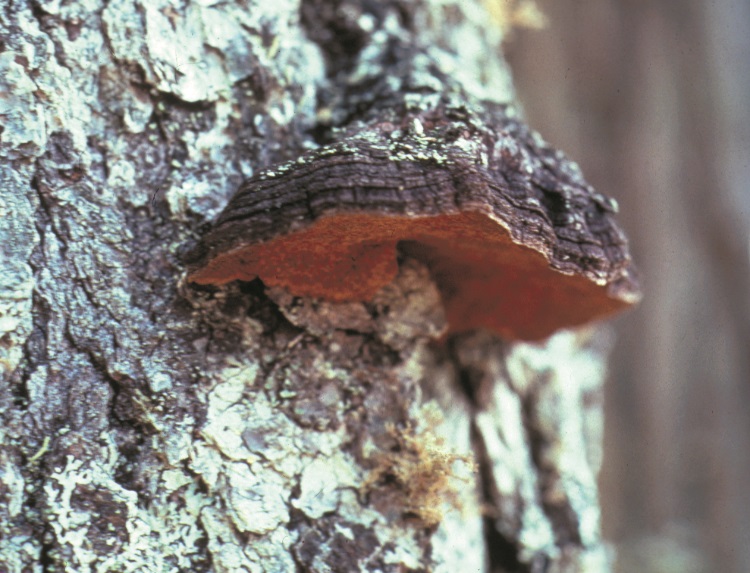
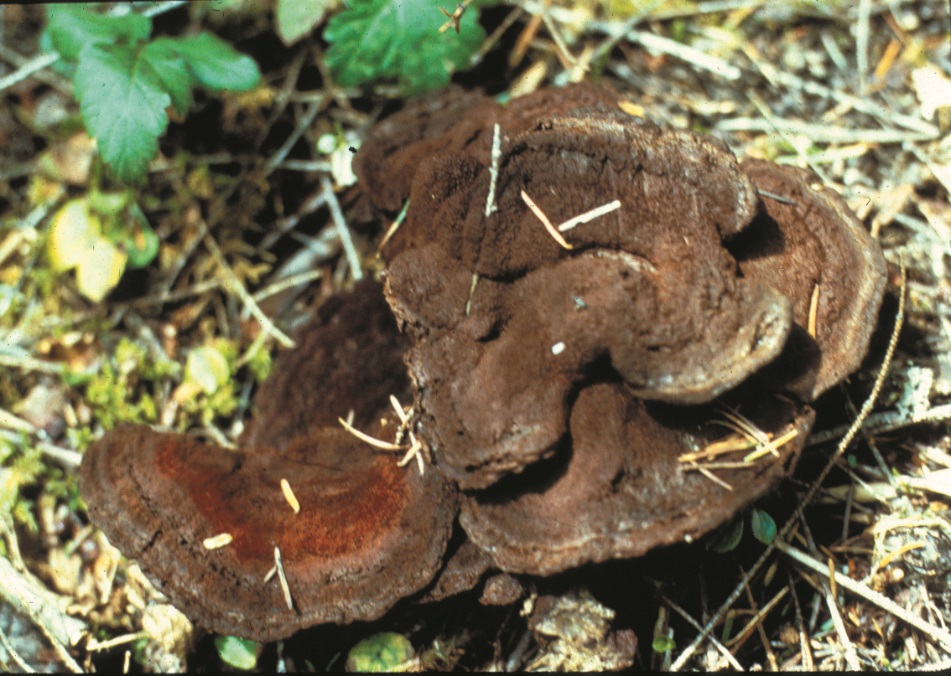
How to Minimize the Risk of Adverse Effects:
Reduce injury to residual trees during selective harvest activities by limiting the number of entries, restricting the operating season to summer, fall, and winter when wounding is less likely to occur, limiting the size and type of equipment, and controlling falling and skidding practices. Use pruning techniques that promote fast healing of pruning wounds to avoid creating entry points for heartrot fungi. Pile slash away from the bases of residual trees after harvesting. Avoid underburning stands with a substantial component of true firs or hemlock. Use short rotations. On recreational and administrative sites, trees within striking distance of a target and that have indicators of decay or discernable decay exceeding prescribed levels should be removed or topped to a safe height, or the situation arranged so that people are not exposed to danger.
References
Aho, P.E., G. Fiddler, and G.M. Filip. 1989. Decay losses associated with wounds in commercially thinned true fir stands in northern California. USDA Forest Service, Pacific Northwest Research Station, Portland, OR, Research Paper PNW-RP- 403. 8pp.
Aho, P.E., G. Fiddler, and M. Shigo. 1983. Logging damage in thinned, young-growth true fir stands in California and recommendations for prevention. USDA Forest Service, Pacific Northwest Research Station, Portland, OR. Research Paper PNW-304. 8pp.
Allen, E. A., D.J. Morrison, and G.W. Wallis. 1996. Common tree diseases of British Columbia. Canadian Forest Service, Victoria, B.C. 178 pp.
Bedker, P.J., J.G. O’Brien, and M.E. Meilke. 2012. How to prune trees. USDA Forest Service, Northeastern Area, State and Private Forestry. NA-FR-01-95 (revised). 30 pp. http://www.pueblo.gsa.gov/cic_text/housing/prune/prune.htm
Bull, E.L., C.G. Parks, and T.R. Torgersen. 1997. Trees and logs important to wildlife in the interior Columbia River Basin. USDA Forest Service, Pacific Northwest Research Station, Portland, OR. Gen. Tech. Report PNW-GTR-391. 55 pp.
Filip, G.M. and C.L. Schmitt. 1990. Rx for Abies: silvicultural options for diseased firs in Oregon and Washington. USDA Forest Service, Pacific Northwest Research Station, Portland, OR. Gen. Tech. Report PNW-GTR-252. 34 pp.
Filip, G.M., J. Brio, K.L. Chadwick, D.J. Goheen, E.M. Goheen, J.S. Hadfield, A. Kanaskie, H.S.J. Kearns, H.M. Maffei, K.M. Mallams, D.W. Omdal, A.L. Saavedra, and C.L. Schmitt. 2014. Field guide for hazard-tree identification and mitigation on developed sites in Oregon and Washington forests. USDA Forest Service, Pacific Northwest Region, Portland, OR. R6-NR-TP-021-2013. 120 pp.
Filip, G.M., K.L. Chadwick, P.J. Zambino, D.W. Omdal, A. Ramsey-Kroll, C.L. Schmitt, H. Maffei, A. Saavedra, W. Rall, and C.G. Parks. 2011. Seven- to 14-year effects of artificially inoculating living conifers to promote stem decay and subsequent wildlife use in Oregon and Washington forests. USDA Forest Service, Forest Health Protection, Pacific Northwest Region, Portland, OR. 24 pp.
Filip, G.M., C.A. Parks, F.A. Baker, and S.E. Daniels. 2004. Artificial inoculation of decay fungi into Douglas-fir with rifle or shotgun to produce wildlife trees in western Oregon. West. J. Appl. For. 19(3):211-215.
J.A. Glaeser and K.T. Smith. 2010. Decay fungi of oaks and associated hardwoods for western arborists. Western Arborist, Winter 2010:p. 33-46. http://www.nrs.fs.fed.us/pubs/jrnl/2010/nrs_2010_glaeser_003.pdf
Goheen, E.M. and E.A. Willhite. 2006. Field guide to common diseases and insect pests of Oregon and Washington conifers. USDA Forest Service, Pacific Northwest Region, Portland, OR. R6-NR-FID-PR-01-06. 335 pp. http://www.biodiversitylibrary.org/bibliography/80321#/summary
Hansen, E.M. and K.L. Lewis, eds. 1997. Compendium of conifer diseases. American Phytopathological Society Press. 101 pp.
Harvey, G.M. 1962.Heart Rots of Douglas-fir. Forest Pest Leaflet 73. USDA Forest Service, Washington, D.C. 8 pp. https://www.fs.usda.gov/Internet/FSE_DOCUMENTS/fsbdev2_043429.pdf
Hennon, P.E. 1995. Are heart rot fungi major factors of disturbances in gap-dynamic forests? Northwest Science, 69(4):284-293.
Hennon, P.E. and R.L. Mulvey. 2014. Managing heart rot in live trees for wildlife habitat in young-growth forests of coastal Alaska. U.S. Department of Agriculture, Forest Service, Pacific Northwest Research Station, Portland, OR. Gen. Tech. Report PNW-GTR-890. 23 pp. http://www.fs.usda.gov/Internet/FSE_DOCUMENTS/fseprd496123.pdf
Hepting, G.H. 1971. Diseases of forest and shade trees of the United States. USDA Forest Service, Ag. Handbook 386. 658 pp.
Kimmey, James W. 1964.Heart rots of western hemlock. Forest Pest Leaflet 90. USDA Forest Service, Washington, D.C. 7 p.
Worrall, James J.; and Fairweather, Mary Lou. 2009.Decay and Discoloration of Aspen. Forest Insect & Disease Leaflet 149 (revised). USDA Forest Service, Portland, OR: FS-R6-RO-FIDL#149/005-2009. 8 pp. http://www.fs.usda.gov/Internet/FSE_DOCUMENTS/fsbdev2_043691.pdf
Mallams, K.M.; K.L. Chadwick, and P.A, Angwin. 2010. Decays of White, Grand, and Red Firs. Forest Insect and Disease Leaflet 52 (revised). USDA Forest Service, Portland, OR. FS/R6/RO/FIDL#52-10/003. 12 pp. http://www.fs.usda.gov/Internet/FSE_DOCUMENTS/fsbdev2_043723.pdf
Ohman, J.H.; and K.J. Kessler, Jr. 1964. White Trunk Rot of Hardwoods. Forest Pest Leaflet 88. USDA Forest Service, Washington, D.C. 7 pp. http://www.fs.usda.gov/Internet/FSE_DOCUMENTS/fsbdev2_043596.pdf
Parks, C.G., D. Hildebrand. 2002. Experimental techniques for inoculation of trees with stem decay to create wildlife habitat—laboratory and field procedures. Draft Handbook. U.S. Department of Agriculture, Forest Service, Pacific Northwest Region, Portland, OR. 24 pp.
Scharpf, R.F. 1993. Diseases of Pacific Coast conifers. USDA Forest Service, Pacific Southwest Research Station, Albany, CA, Ag. Handbook 521 (revised). 199 pp.
Swiecki, T.J. and E.A. Bernhardt. 2006. A field guide to insects and diseases of California oaks.USDA Forest Service Pacific Southwest Research Station, Albany, CA. Gen. Tech. Report PSW-GTR-197. 151 pp. http://www.fs.fed.us/psw/publications/documents/psw_gtr197/psw_gtr197.pdf
Worrall, J. J.; and M.L. Fairweather. 2009. Decay and Discoloration of Aspen. Forest Insect and Disease Leaflet 149 (revised). USDA Forest Service, Portland, OR. FS-R6-RO-FIDL#149/005-2009. 8 pp.
http://www.fs.usda.gov/Internet/FSE_DOCUMENTS/fsbdev2_043474.pdf
Website links
The Seen and Unseen World of the Fallen Tree, USDA Forest Service General Technical Report
How to Prune Trees, USDA Forest Service publication